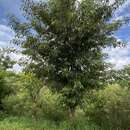en
names in breadcrumbs


Vitex megapotamica is a hardwood fruit tree found in Argentina, Paraguay, Uruguay, and southern Brazil.[2][1][3][4][5] In Brazil it is commonly called tarumã.
The tarumã grows to be up to ten metres tall.[5] Its bark is coloured dark grey; its compound leaves have a long petiole and five elliptic leaflets.[5] The small, abundant flowers developed into fleshy stone fruit. The fruits are eaten by a number of species, and serve also as fishing bait.[5]
Tarumã grows from the Southeast Region of Brazil to the South Region, and on through Uruguay and Paraguay to Argentina.[5]
In Brazil, its common names include azeitona do mato (forest olive), azeitona brava, cinco folhas (five leaves), copiúba, sombra de touro (bull's shadow), and tarumã romã (tarumã pomegranate).[5]
Vitex megapotamica is a hardwood fruit tree found in Argentina, Paraguay, Uruguay, and southern Brazil. In Brazil it is commonly called tarumã.
The tarumã grows to be up to ten metres tall. Its bark is coloured dark grey; its compound leaves have a long petiole and five elliptic leaflets. The small, abundant flowers developed into fleshy stone fruit. The fruits are eaten by a number of species, and serve also as fishing bait.
Tarumã grows from the Southeast Region of Brazil to the South Region, and on through Uruguay and Paraguay to Argentina.
In Brazil, its common names include azeitona do mato (forest olive), azeitona brava, cinco folhas (five leaves), copiúba, sombra de touro (bull's shadow), and tarumã romã (tarumã pomegranate).